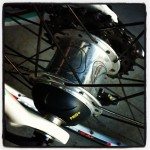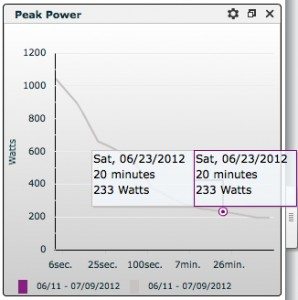Training with power is consistently hailed as the next step for any cyclist who is looking to improve their fitness. While that's true, most cyclists who are in the market for a power meter are hesitant to purchase one. The biggest reason I've run into is hesitation on how to actually utilize such an instrument.
But why?
A power meter is wonderful and spits out bucket loads of data, but the one thing that it won't do is make you faster. It will, with some practice and some simple analysis allow you to train to become faster. In this series of articles, we'll look at a few of the basics that beginning power meter users need in order to train smarter.
Click through for some definitions you'll need to know when you start training with power:
 Training with power – key terms you need to know
Training with power – key terms you need to know
It helps to know what we're talking about, right? So let's take a look at some terminology surrounding training with power.
Functional Threshold Power: Abbreviated FTP, it is the measure of wattage you can produce at one hour without fatigue. This roughly corresponds to lactate threshold or aerobic threshold and is best measured by a 60 minute TT (although there are other ways we'll discuss later.)
Power to Weight Ratio: A simple mathematical formula, usually expressed in Watts/Kilogram (of body weight) that essentially defines the ability to propel yourself (and your bike) down the road. Raising this ratio is typically a key to improving your racing and training success. It's especially important to consider when the road tilts uphill.
Power Training Levels: Along with FTP, these dictate (roughly) the energy systems used at certain power levels and allow a rider to train specific systems to get specific gains. These may be described as “zones” or “levels” interchangeably.
Power Profile: One of two metrics that will help you identify strengths and weaknesses. It is also a key way to determine if you are putting too much time into one specific energy system and neglecting others. It determines power/weight ratio for various “critical power” points and gauges them versus typical power/weight ratios for various racing categories.
Fatigue Resistance Profile: The second key to identifying strengths and weaknesses. A fatigue resistance profile helps you to determine what your “winning strategy” should be. Will you be the drag racing sprinter who goes from 300 meters out or the guy who can blow the doors off a Ferrari in the last 50 meters? Do you solo in from the 5K to go banner or do you save it for the Flamme Rouge? The fatigue resistance profile helps you tailor your strategy to your strengths.
We'll start with an overview of FTP and power to weight, with the other factors being reviewed in later posts.
Functional Threshold Power
As stated above, Functional Threshold Power (FTP) is a measure of how many watts an athlete can produce for an hour without dropping off. It is an excellent measure and predictor of performance. It is also the basis of measuring all workouts and is how we determine effort levels for intervals. You can also think about it as the sustainable 100% level. You'll know from experience that if you go out and hammer for all you're worth for about 1 minute, you certainly can't maintain that pace for an hour. If you go out and spin easy, you know you can probably do that for a long time. Essentially, it boils down to this: efforts below FTP are sustainable, efforts above FTP are not.
So how do we find our FTP?
Calculating FTP through a true 60 minute TT is the ideal way to determine what your FTP is. But let's be realistic: there are very few times we're willing to sit on a trainer for an hour and pedal at TT power. If you're outside, the chances of finding a route with few hills, cars, intersections, stop lights, stop signs and a lack of variable wind is just about nil. On top of those issues, very often indoor and outdoor 60 minute FTP tests yield quite different results. Bearing all those factors in mind, ideally, you'd have a 60 minute (25-ish mile) TT from a race which you can reference because that is the best way to measure FTP.
 Barring that, a 20-minute test is the next best thing. A 20 minute TT is much easier to accomplish both indoors and out, and simply multiplying the 20-minute average power by .95 will give you FTP (within a few percentage points of accuracy.) For example, an athlete does his “20-minute test” and he averages 233 watts over 20 minutes. Multiplied by .95 gives us 221 watts FTP. Remember this number for later, because this will be our “100% sustainable” effort that we base our power training zones on. It is also what we use to predict power to weight, which is a good predictor of performance.
Barring that, a 20-minute test is the next best thing. A 20 minute TT is much easier to accomplish both indoors and out, and simply multiplying the 20-minute average power by .95 will give you FTP (within a few percentage points of accuracy.) For example, an athlete does his “20-minute test” and he averages 233 watts over 20 minutes. Multiplied by .95 gives us 221 watts FTP. Remember this number for later, because this will be our “100% sustainable” effort that we base our power training zones on. It is also what we use to predict power to weight, which is a good predictor of performance.
Power to Weight Ratio
As stated before, power to weight ratio is a key determinate in cycling performance, particularly when climbing. Overall, it gives a good picture of how successful an athlete can be, but its value is limited in flat terrain. Take our athlete above with the 221 watts FTP. Assuming he is a larger athlete, say about 180 pounds (about 82 kilograms) he would have a power to weight ratio of about 2.6 W/Kg (221W/82Kg.) This would put him squarely at the Cat 5 level of racing.
However, if a 65Kg athlete puts out the same power, he would have a power/weight ratio of about 3.4 W/Kg. This would put said athlete squarely at the Cat 4 level.

With that example in mind, imagine how you can improve by simply losing weight? Every pound shed increases the power/weight ratio, making weight loss “free speed” at the end of the day. This will be most noticeable in hilly terrain where it's well known that carrying around extra weight will do nothing but slow you down. Consider the graphic above: that 65Kg rider only has to ride about 12% over threshold to climb at4+ W/Kg. That 82Kg rider has to put out around 331 watts in order to hit 4+ W/Kg. Assuming both riders have the same FTP, the 82Kg rider needs to ride at 150% FTP just to keep up with the skinny guy! You'll see later on that this is near on impossible due to the energy systems involved. Now if that's not motivation to lose a few inches off the midsection, I'm not sure what is.
Unfortunately, weight loss is another topic altogether. The real way to get a benefit from your power meter is to use your FTP to design workouts. I'll cover next time in the Beginner's Guide to Training with Power – Part 2.

One thought on “Beginner’s Guide to Training With Power (part 1)”
Comments are closed.